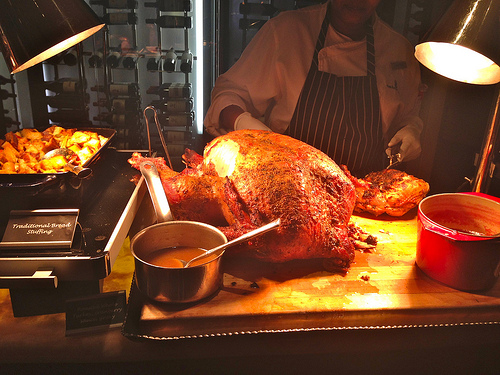Corporate Catering and Your Thanksgiving Turkey: The Science Behind Why Your Meal Appears So Tasty
Posted by Amelia K. on Thursday, November 27th, 2014 with 4 Comments
When it comes to today’s celebration, your focus is probably on making sure the food is delicious, that the table is perfectly set, and your guests are having a good time. One thing that you likely won’t have to think about is why your Thanksgiving turkey (and the rest of your delicious spread) looks so yummy. There’s actually a lot of science and research that goes into just that: our visual perception and sensory analysis determine how foods should appear and when different products are at peak freshness and quality.
Special tools, including something called visual spectroscopy, are used to measure the color differences regarding the foods we eat to make them look a whole lot tastier when they show up on our tables, whether it’s a light lunch or a big feast, like Thanksgiving. Because we all are, somewhat unknowingly, judging whether our food is good based on what it looks like, and we tend to associate specific colors with the quality of the foods we buy, food producers have to use the newest technologies to make sure their products are not only acceptable to those of us shopping at the grocery store, but also to the chefs at the restaurants they supply.
Ready to learn more and have something unique to talk about at your Thanksgiving dinner? We’ll tell you all about this fascinating food research below!

Whether it’s for a company event or your Thanksgiving table, the foods we eat are made to look delicious based on how our brains perceive color. How cool is that?
Image source: Flickr user Sarah_Ackerman
What Does Food Color ‘Taste’ Like?
Think about how you perceive color when you order food from your favorite restaurant: you can likely tell, based on a quick glance, whether your food looks completely cooked or not. You knew when those cookies you made last night were overdone, because the color was way too dark – indicating they would have a burnt taste when you took a bite. And you know when a fresh salad really is made with ripe ingredients because the color indicates whether those strawberries were picked too soon or if the lettuce is a few days past it’s prime.
Although it’s not something we consciously do, there are pre-determined appearances in our brains that make foods more appealing. And food producers don’t just know this, they actually rely on fancy technology to ensure that they’re able to consistently produce ingredients that match up to our expectations. They know that if they don’t, we’ll most likely purchase products from their competitors. Tools like spectrophotometers (the technology used to measure the colors in our food and other products) are how food producers apply their research and findings to make sure specific colors and appearance will match our expectations. So there really is a lot of science that goes into how we choose our food!
Visual Spect-ro-what?
We know it’s a mouthful – but it’s also kind of fun to say, once you get the hang of it. When it comes down to it, visual spectroscopy is a quick and super accurate way that food producers automate how they analyze foods. Visual spectroscopy can actually do more than just make sure foods have the best coloring to encourage us to buy them – it’s also a way to determine the freshness and quality of the meats we get at the butcher or the grocery store. There is a range of colors that different meats should exhibit when they are safe to consume. Red meats should also have a certain amount of marbling throughout, which can’t always seen by the naked eye. By using the right tools, meat producers can easily analyze the health of their products by measuring these factors. And visual spectroscopy is one of those tools that helps them do this with more accurate results than human inspection yields.
Technology and Your Kitchen Table
Whether you make your Thanksgiving meal yourself have it catered for the sake of simplicity, it’s interesting to know that the color of your food is part of what makes it look and taste so delicious! Plus, you can rest easy knowing that the meats you eat – including that Thanksgiving turkey – are safe, thanks to improved technology that makes a more accurate screening process possible. And if you’re looking for something interesting to chat about at your Thanksgiving table tonight, you’ve definitely got a new conversation starter!
On this day of thanks, Waiter.com wants you to know that we’re thankful for YOU, our loyal readers and site users. Whether you choose to make your fancy Thanksgiving dinner yourself or have it brought in from a local restaurant, we hope you have a fabulous meal and are surrounded by friends and fmaily. And if you want to recreate some of those delicious Thanksgiving tastes next week, we’re happy to provide some yummy corporate catering ideas for you!
When it comes to feeding employees and coworkers, make your company's food program really count! If your workplace dining plan needs to take it up a notch — or if you don't have one at all — Waiter.com is here to help. From Virtual Cafeteria Service to diverse menus to local takeout & delivery, Waiter.com offers customizable dining solutions for every business and budget. Contact us today to get started!

I think we all know a nice roasted turkey is a certain color,but I have never made one that looks like that picture. That thing looks so tasty, its good to know all this knowledge and tech goes into Thanksgiving.
It definitely makes me crave a little more Thanksgiving today!
I had no idea that so much science goes into making sure our food is the right color! Definitely something to think about. Interesting.
It’s a really cool tidbit!